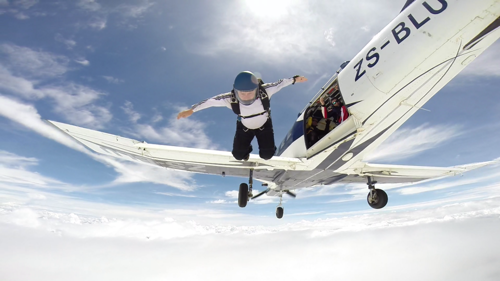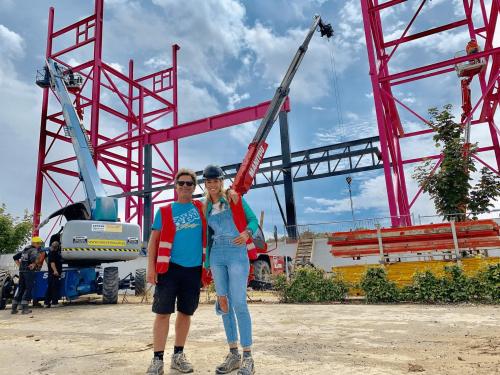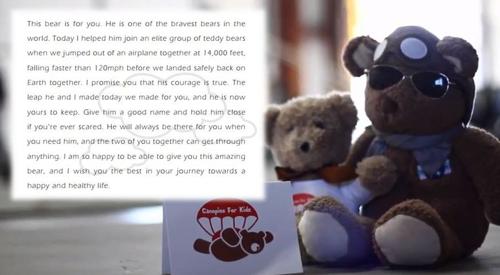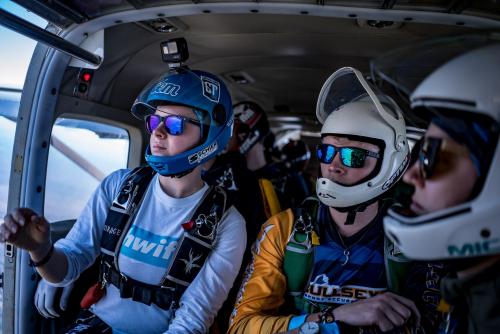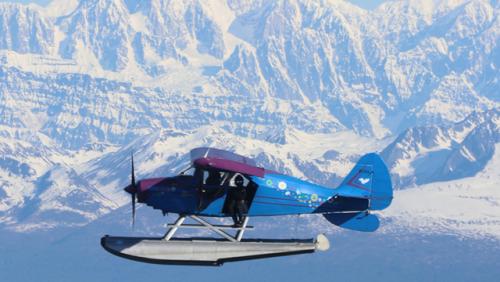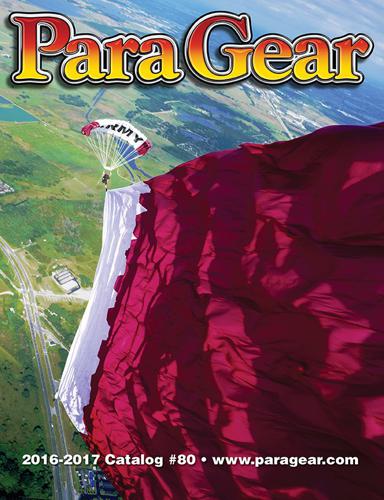Down For 50 Jumps Alaska, And Annette O’Neil Tries to Rise to the Occasion
Image Credit: Melissa Dawn Burns
When I grapple my way out onto to the float, I notice two things immediately.
First: It’s impossible to maintain a relaxed attitude while sitting on the pontoon of a floatplane in full flight. My mental image of myself doing this is going to take a major revision in the translation to reality.
Secondly: My pilot chute has never felt so vulnerable in all my jumps. For almost the entirety of this once-in-a-lifetime skydive, as I keep a resolute smile trained on the camera aircraft flying next to us, a sepiatone clip plays over and over in my head: A pinch of (actually very securely and conscientiously packed) fabric managing to wiggle itself out of my (actually tight-as-a-new-pair-of-jeans) BOC and bolt mischievously between the pontoon and the step, deploying my beautiful new Crossfire one last time as we spiral, nose-first, into Alaska’s forested wetlands.
But I digress.
Before we came to Alaska, we were warned.
“Ah, mosquitoes: Alaska’s state bird,” said one. “They don’t bite you. They carry you home and feed you to their children.”
“You’re only there for five days?!,” breathed another. “Good luck with that. You should have planned on at least a week. You’ll never get a break in the weather.”
“A college kid just got eaten by a bear while he was running a half-marathon out there in Anchorage,” chimed in another. “It chased him off the trail and into the forest. He was calling his mom as it was running him down.”
Since my previous knowledge of Alaska was gleaned almost entirely from the Calvin & Hobbes ‘Yukon Ho!’ collection and a single viewing of Grizzly Man, I’m a receptive audience. I decide not to go for runs.
When I arrive in Anchorage, I walk through a neighborhood from my airport hotel to a car rental storefront. The gardens, clearly nothing more than a salad bar for the local deer population, have been scrupulously stripped of anything edible. The one with remaining flowers is surrounded by a high fence. A woman crosses in front of me, walking her toy yorkie. She is carrying bear spray. I speed up, having no toy yorkie to cast off as bait.
Image Credit: Melissa Dawn Burns
When I get to the rental place, they issue me a Subaru. Clearly, they assume I’m not messing around.
And clearly, we are not.
The next morning, we—myself, my Down For 50 co-adventurer, Joel, and Brett, along for the ride on this particular state’s adventure—are on the road, bound for the town of Talkeetna. Ah, Talkeetna, Alaska: the acknowledged “doorway to Denali,” home to a heterozygous mix of hippies and lumberjacks, a private pilot mecca. The latter becomes evident even miles away, on the long road into town. The traffic overhead, after all, is significantly more congested and varied than the traffic on ground level. I’m glad I’m not driving; I’m transfixed looking out and up, checking out the rush hour trucking over the trees.
Soon, following the instructions given in a flurry of arranging emails, we wind through a series of deeply wooded roads to arrive at our pilot’s lakehouse/hangar/office/flight school/community hub. The pilot himself, Don, is an affable fellow with a handsome mustache and the air of a man you’d immediately trust with your life. In fact, I do: When he suggests that we head over to the airport to conduct a quick aerial requisition of the available parachute landing areas “in the Breezy,” I immediately offer myself up. We hop in the rough-and-ready fuel truck (okay: the rusted-through blue pickup with a tank of AV gas in the bed) and off we go.
The airfield is, to put it mildly, a candy store.
All manner of aircraft sit gamely waiting, lined up as tidily and fetchingly as pretty ladies in an Old West brothel, all waiting expectantly for a pilot. Don and I cruise along in front of their expectant glass faces. Will we hop into the shiny red one? The bare-metal number that looks like it’ll have a sign on the door that says “silk scarves required”? The race-car-faced green-and-white one with its dancing shoes on and the freshly-chamwowed gleam?
What’s this blue thing?
As I’m wondering what I’m looking at, we pull to a stop. I take a closer look. This aircraft—I’m finding it difficult to call it a “plane”—is a robin’s-egg-blue latticework of metal with a wing laid across the top. There’s a prop. There’s an engine. There’s a Wizard-of-Oz-style picnic basket strapped in for storage behind an open, park-bench seat. It looks like the pilot is meant to perch on a piece of wood that sits directly in front of that.
Suddenly, I realize that Don’s walking right towards it.
Oh. The BREEZY.
That looks pretty breezy, alright.
Don hands me a motorcycle helmet and a bib jumpsuit “so he doesn’t have to worry about me.” I sit down on the park bench. I fasten the single lap belt as fastidiously as I can manage. Then, as Don works the engine like a lawnmower, I read the little metal placard fastened to the seat in front of me. It says, “Passenger warning: This aircraft is amateur-built and does not comply with the federal safety regulations for standard aircraft.”
For some reason, that’s all I need to start enjoying myself. As we taxi out, I’m smiling so hard in my helmet it hurts a little.
Twenty minutes later, I’ve found Jesus. I’m reeling from the feeling of being in the dead-on sweet spot of everything I love about flying and motorcycling and adventuring, all bound up into one ugly-ass not-quite-aircraft. We rode the river like a track day. We bounded over forested hillocks and gravel outcroppings and one enormous, out-of-place old satellite dish. We buzzed the lakehouse, waving at my astounded companions. As we land, I decide I might not be bluffing about wanting my fixed-wing license anymore. I tell Don.
“Oh, you don’t need a pilot’s license to fly this thing,” he grins. “I can get you checked out on it this afternoon.”
I backpedal. Hard.
When we arrive back at camp, it’s late. It doesn’t look late, but it is late. Don, the pilots and us jumpers congregate on the dock, four floatplanes bobbing cheerfully around us, and go over the flight plan. As it turns out, they want to do our jump as a stacked formation—each of us in our own chariot—with queenly Denali throwing her white skirts around in the background. There will be a photographer (my preternaturally gifted, multi-hyphenate wonder of a friend, Melissa) passenging in a camera plane, ready to capture it. Our flight instructors thrill to the plan. I am assigned the one that’s mostly purple, bedecked with little hippie daisies. I am much pleased.
After the meeting, Joel and Brett and I trundle up to the room that Don has graciously offered us, with its wide deck overlooking the twilit lake and the visiting pilots trading stories around the fire pit. We (very ineffectually) close the shades. We try to rest. Tomorrow’s a big day.
Image Credit: Melissa Dawn Burns
The night segues seamlessly into the morning. I wake when my sleep mask shifts and the 4:30AM sun sears my eyelids. Brett wakes when I bump his shins, hanging over the padded arm of the loveseat upon which he reclines. Joel is already up.
Coffee in hand, we meander down to the dock under a cloudless, bluebird sky. There’s a four-month-old Bernese-Blue Heeler mix rolling around the lawn, doing its best to learn how to be a dog, its fur bunching adorably in handfuls, waiting to be grown into. Two chubby golden retrievers stalk fish offshore. Two pigs, wire-haired and curious, wander over and present themselves for belly rubs. We kit up.
Taking off from water is a new experience entirely. It’s smoother than I think it’ll be, as the glassed-off lake is feeling nary a tickle of wind this fine, blue morning. Before I know it, we’re tooth-and-clawing our way up to six grand.
“I forgot how pretty it is from up here,” my pilot smiles when we get to around four. I, for myself, had forgotten that most people—especially people around here—don’t blow through four grand like the front door on a cold night.
Once we’re up at six, we circle, building the formation. Let’s be clear: these are really, really good pilots, but they’re not formation pilots, and there’s most certainly a trick to it when you’re wrangling low-performance aircraft that were made to do nothing of the sort. With the door open, six thousand feet over Alaska at the entrance to glaciertopia, it is cold. The twenty minutes it takes them to get together has me clinging to the back of the passenger seat like it’s a lover returned from the wars. I hope my hands still work when it’s time to get out.
Image Credit: Down For 50
Which, coincidentally, it is.
I see Melissa’s plane figuring its way alongside us. I uncertainly stick out a foot and screw it down onto the sandpaper surface of the step. Then I offer my body up to the full blast of the relative wind and lunge for the strut. I get a purchase. I, ungainly, perch. I’m doing it.
There’s a yoga to staying here, one iron grip around the strut, the other hand “casually” in my lap, my brain stuck firmly to my pilot chute. Most of me aches to tumble into the familiar arms of freefall. The rest of me grabs that part of me by the cheeks and shouts into its face: For chrissakes, woman, pay attention to this and here and now, because it has an expiration date that is less than a minute in the future and this is what you came for.
I heed it.
Suddenly, I can see. I see the red and white camera airplane, framed by impossible mountains. Denali, of course; Mount Huntington; Moose’s Tooth; Little Switzerland. I see a sky of a blueness Alaska pretty much never sees, yet here I am, sitting in it. I see Melissa, concentrating behind the winking black eye of her lens. I can’t see them, but I feel Joel and Brett, doing their own pontoon yoga practice behind me and above me. I see so much of what I love about being in this world, hanging here and now in the suspended animation of complete attention.
And then there’s the landing area below—a cleared construction pad, tucked up next to the Talkeetna airport runway. My pilot nods. I had planned some sort of fanfare for this exit. As it stands, however, all I can manage is a dizzy-eyed smile and a bog-standard hop. My pilot hollers to watch me go. She’s never seen anything like it before.
When we land, parachutes slung over shoulders, I’m exhausted with the effort of committing it all to memory. I decide to walk back to the FBO and let it all process—Don’s generosity; the force of the community here; the entirely new sensations of flight. It overwhelms my hardware.
It’s only later, as we hunch over plates heaped with pancakes, that I happen to glance at the collection of grinning pilots clustered in black-and-white on the Talkeetna diner wall. It crystallizes what I’m feeling: The momentum of a long tradition. Those smiling faces, proudly next to their planes, captured over the entire history of aviation, seem to prove that this place—Alaska, the last frontier—was created by and for adventure. Alaska turns energy to adventure like some sort of spiritual chlorophyll. Every single one of these guys grew tall, strong, enduring lives with the force of that alchemy. Alaska pushes out the envelopes of the willing like leaves bursting from ever-lengthening branches. This is its job.
It does it well.
-----------
Down For 50, the first 50-state skydiving road trip accomplished in a single journey, is happening from May to October of this year. To follow the journey, to check out when it’s coming to your state or simply to help out (thanks!), visit downfor50.org.

